-
- Trading Platforms
- PU Prime App
- MetaTrader 5
- MetaTrader 4
- PU Copy Trading
- Web Trader
- PU Social
-
- Trading Conditions
- Account Types
- Spreads, Costs & Swaps
- Deposits & Withdrawals
- Fee & Charges
- Trading Hours


U.S. equities took a hit as concerns over corporate earnings weighed heavily on investor sentiment, a sentiment that spilled over into Asian markets. The market’s risk appetite has contracted due to fears of a possible recession following softening U.S. manufacturing data and a slowdown in the labour market. The dollar also saw a dip, while gold prices once again climbed above the $2000 mark amid an uncertain economic outlook. Adding to the market’s worries, oil prices extended losses for the third consecutive session as a result of expectations for slower global oil demand. As the Bank of Japan officials prepare for their policy meeting next week, the hope for any tweaking or scrapping of the yield curve control has diminished, particularly after the recent failure of banks in the U.S. and Europe have caused further economic uncertainties.
Current rate hike bets on 3rd May Fed interest rate decision:
Source: CME Fedwatch Tool
25 bps (16.3%) VS 50 bps (83.7%)




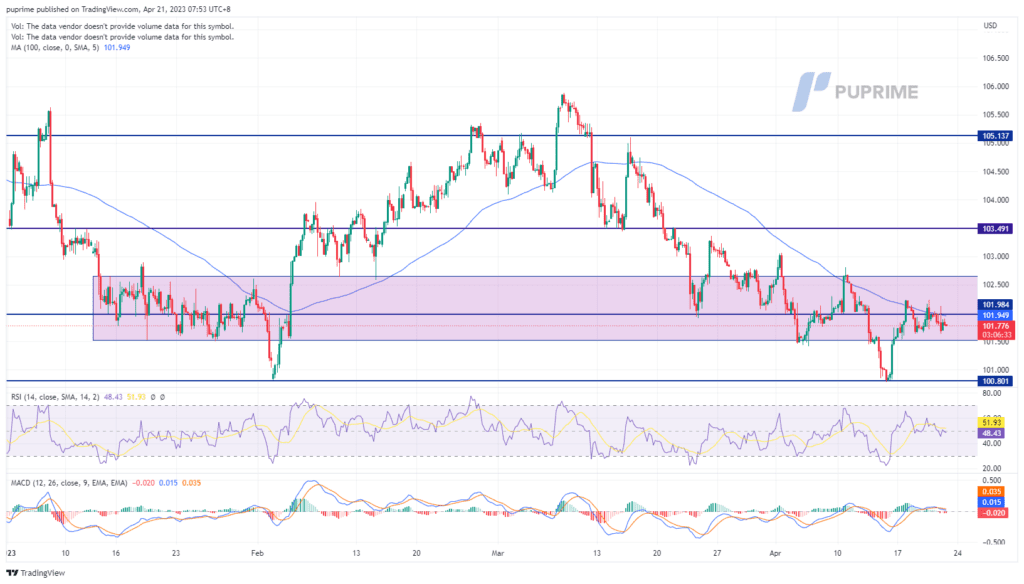

Following the disappointing macroeconomic data, the US Dollar struggled to trade above $102. Despite a hawkish stance from the Fed with the high expectation of a 25 bps rate hike next month, a looming recession has pressured the dollar to trade higher. The recent release of the Fed’s Beige book showed that the economic activity was flat or down, reinforcing the belief that a recession is around the corner. A softening labour market and declining existing home sales also support the view. High CPI from other countries, such as Euro and the UK, has also suppressed the dollar from trading higher.
The Dollar Index is traded with a lower high in April and the volatility is minimal this week. Both the RSI and MACD depict a neutral signal for the DXY with RSI hovering near the 50-level while the MACD stays flat.
Resistance level: 101.9, 103.49
Support level: 101.50, 100.8
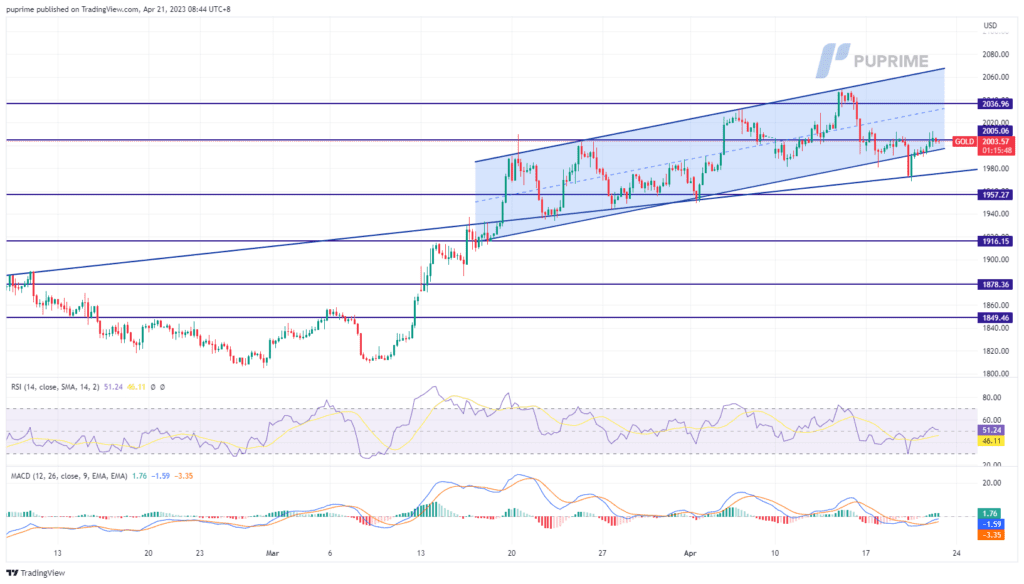

Gold prices jumped above $2000 once again on softer U.S. economic data as well as a weakening dollar. Signs of slowing down in economic activities which reveal in the recently released Fed’s Beige book as well as softening labour market, prompted the Fed may end its monetary tightening campaign sooner. The increasing recession risk and worry over corporate earnings as well as simmering geopolitical tension, stimulate these safe-haven assets to trade higher. Investors are eyeing the economic data that will be released next week including the CB consumer confidence and the U.S. GDP, to gauge the economy’s health and the price movement of gold.
Gold prices are trading higher and are back to the psychological level at $2000. The RSI has rebounded while the MACD has a convergence which both depicted a reversal in the gold price trend.
Resistance level: 2005.00, 2036.90
Support level: 1957.27, 1916.15
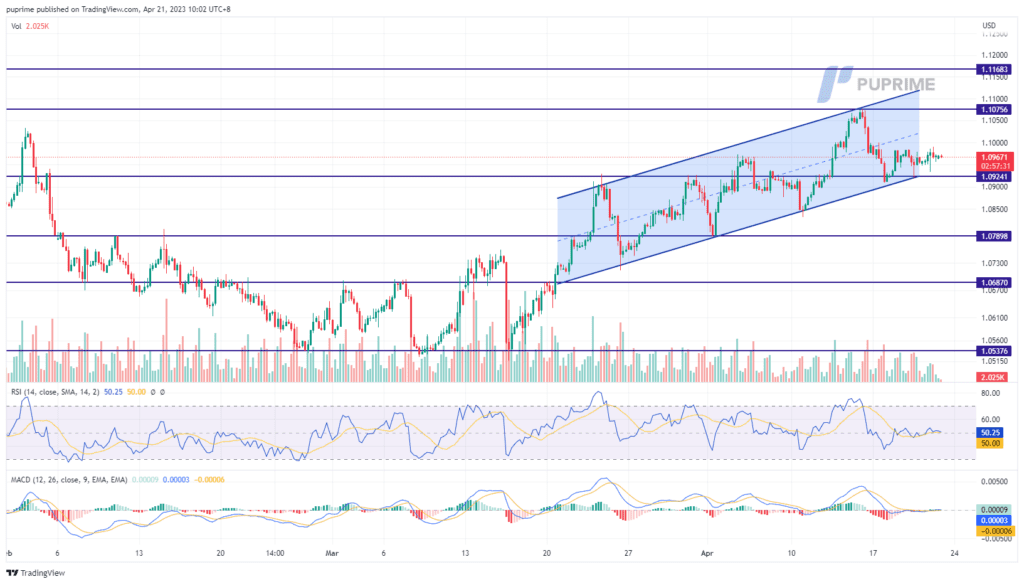

The pair has traded in a narrow range this week as the market lacks direction. The dollar index has been sideways despite hawkish stance from the Fed as the U.S. economic data is not favourable. Both the Euro and the U.S. will be releasing its manufacturing PMI data later today and investors may gauge the pair’s price movement by referring to the data. a lower reading of the manufacturing PMI data may have a negative impact on the currency.
EUR/USD is trading flat and buoyed above 1.0950. The indicators depict a neutral signal for the pair with the RSI staying near to the 50-level while the MACD flows along the zero line.
Resistance level: 1.1075, 1.1168
Support level: 1.0924, 1.0790
Support level: 26890, 25050
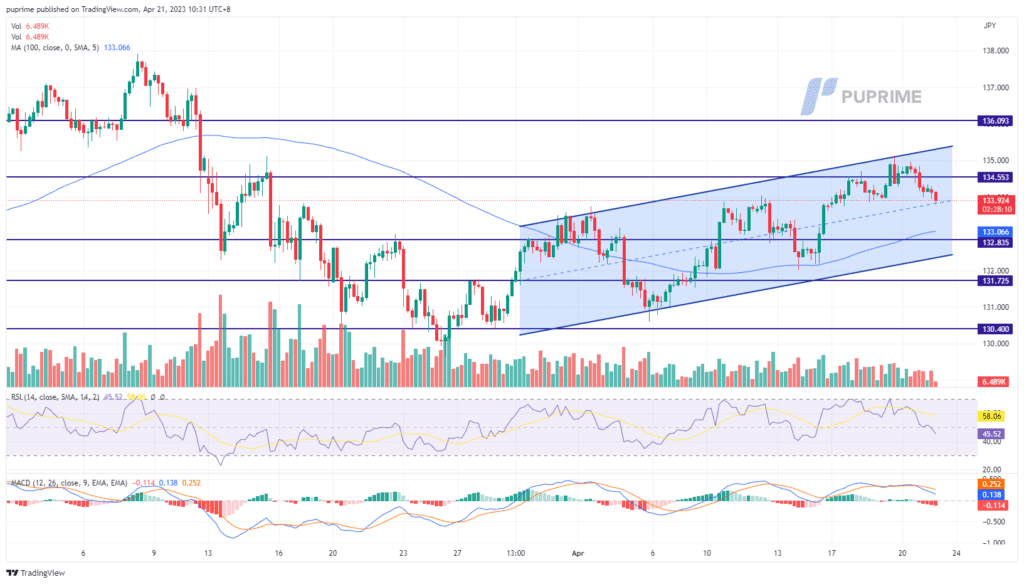

The new Japanese governor will hold his first policy meeting next week. The market has previously anticipated the BoJ to tweak or scrap the YCC, given the inflation rate is high in the country and experienced wage growth for the first time after decades. However, the policymakers are extra cautious in changing its current monetary policy especially after the banking crisis which clouded Japan as well as global economic outlook. The final policy decision is believed to be made after assessing economic data and the developments in the financial market.
The Japanese Yen is depreciating against the weakening dollar as the USD/JPY trades upward. However, the RSI has declined from the top while the MACD has converged from the above suggesting the bearish momentum is forming.
Resistance level: 134.55, 136.10
Support level: 132.84, 131.73
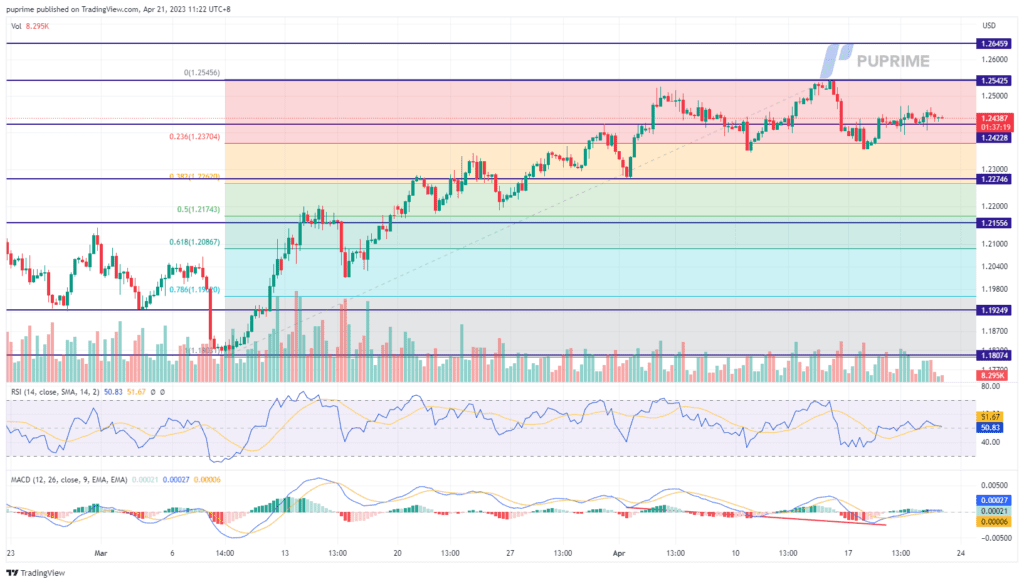

Despite the UK CPI coming higher than the market expectation and bolstering the chance for the BoE to be more aggressive in raising interest rates, the cable is trading flat within the range of 1.247 to 1.240 for the past few sessions. The weakening dollar allowed the Sterling to buoy above 1.2400 as the economic data in the U.S. is not optimistic for the Fed to be hawkish in the upcoming rate decision. Investors are shifting their focus toward the U.K.’s Retail Sale data to gauge further price movement for the cable.
GBP/USD is trading flat following the prior rebound from the support level. However, MACD has illustrated diminishing bullish momentum, while RSI hovers around the 50-level, suggesting the pair is waiting for a catalyst to trade to either side of the trend.
Resistance level: 1.2540, 1.2650
Support level: 1.2270,1.2156
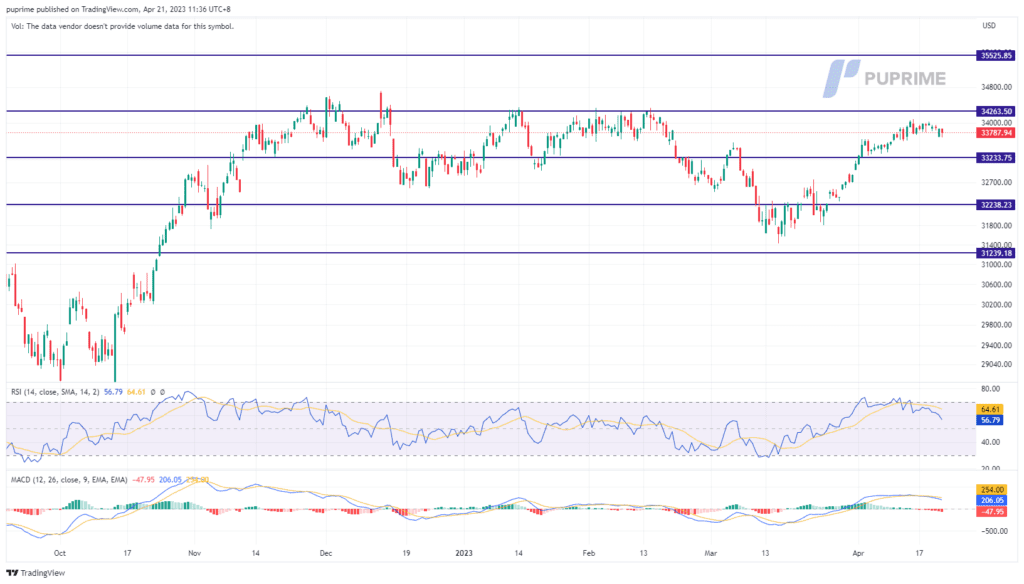

The Dow Jones Industrial Average closed slightly lower last night and has been moving flat since entering the earning season. Investors are worried over corporate earnings as the steep interest rate hike imposed by the Fed since last year may have an effect on corporate earnings this quarter. A high-interest rate environment may slow down economic activities and discourage investment due to the higher cost of borrowing which is in line with disappointing quarterly earning reports from major companies. There will be more earning reports disclosed and investors also seeking clarity on the interest rate path.
The Dow Jones index is still suppressed by its strong resistance level at 34000 waiting for a catalyst to break through. The RSI has moved downward from the overbought zone while the MACD has moved flat on the above suggesting that the bullish momentum is diminishing.
Resistance level: 34263, 35520
Support level: 33233, 32238


Oil prices continue their bearish trend for the 3rd continuous session amid the fears of recession. Despite a surprise drop in U.S. crude stockpiles, oil prices are hammered with selling pressure due to the uncertainty over the dull economic outlook. Notwithstanding the expectation of higher demand from China in the 2nd quarter of this year and oil supply cut from OPEC+, the looming recession has overshadowed these factors and left the oil prices to trade below $80 per barrel. Hawkish stances from various central banks, including the Fed, the ECB and the BoE, may also impact on the oil demand.
Oil prices are trading lower following the prior breakout below the previous support level. The RSI has moved into the oversold zone while the MACD has crossed below the zero line; both suggest that the oil prices are trading with strong bearish momentum.
Resistance level: 78.74, 82.54
Support level: 75.62, 72.45


Trade forex, indices, metal, and more at industry-low spreads and lightning-fast execution.
Sign up for a PU Prime Live Account with our hassle-free process.
Effortlessly fund your account with a wide range of channels and accepted currencies.
Access hundreds of instruments under market-leading trading conditions.